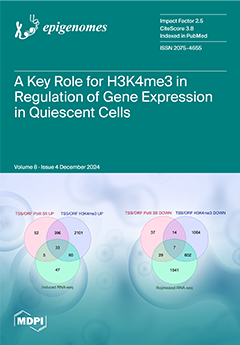Background: Flowers are important plant organs, and their development is correlated with yield in woody fruit trees. For
Pyrus pyrifolia cultivar ‘Sucui 1’, the research on how DNA methylation accurately regulates the expression of TFs and affects the specific regulatory mechanism of flower
[...] Read more.
Background: Flowers are important plant organs, and their development is correlated with yield in woody fruit trees. For
Pyrus pyrifolia cultivar ‘Sucui 1’, the research on how DNA methylation accurately regulates the expression of TFs and affects the specific regulatory mechanism of flower bud wizening will help reduce wizened buds. Methods: Here, the DNA methylomes and transcriptomes of two types of flower buds from the
Pyrus pyrifolia cultivar ‘Sucui 1’ were compared. Results: 320 differentially expressed transcription factors (TFs), in 43 families, were obtained from the wizened bud transcriptome versus the normal bud transcriptome. Most were members of the AP2/ERF, bHLH, C2H2, CO-like, MADS, MYB, and WRKY families, which are involved in flower development. As a whole, the methylation level of TFs in the ‘Sucui 1’ genome increased once flower bud wizening occurred. A cytosine methylation analysis revealed that the methylation levels of the same gene regions in TFs from two kinds of buds were similar. However, differentially methylated regions were found in gene promoter sequences. The combined whole-genome bisulfite sequencing and RNA-Seq analyses revealed 162 TF genes (including 164 differentially methylated regions) with both differential expression and methylation differences between the two flower bud types. Among them, 126 were classified as
mCHH-type methylation genes. Furthermore, the transcriptional down regulation of
PpbHLH40,
PpERF4,
PpERF061,
PpLHW,
PpMADS6,
PpZF-HD11, and
PpZFP90 was accompanied by increased DNA methylation. However,
PpbHLH130,
PpERF011, and
PpMYB308 displayed the opposite trend. The expression changes for these TFs were negatively correlated with their methylation states. Conclusions: Overall, our results offer initial experimental evidence of a correlation between DNA methylation and TF transcription in
P. pyrifolia in response to bud wizening. This enriched our understanding of epigenetic modulations in woody trees during flower development.
Full article






